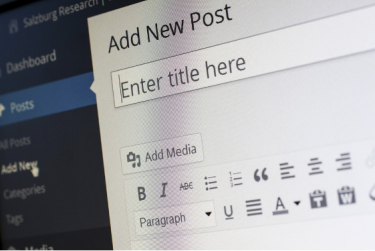6 Actionable Steps to Drafting A Foolproof Website Plan

I’m going to start this off with an old adage.
“If you fail to plan, you’re planning to fail”.
If you start building a website without a plan, it will be like constructing a building without using blueprints. Features will end up in the wrong place, features will be overlooked, and miscommunication will stir up all kinds of structural issues.
On the other hand, going in with a good plan will provide you with clear direction, and prevent some of the avoidable mistakes business owners make when they start working on their website.
If you’re about to start work on your website plan, here’s a guide to hitting the nail on the head…
#1 Establish the Purpose and Goals
The first thing you need to establish is the purpose of your website.
- Are you looking to gain more publicity for your business?
- Attract investors for a new idea? Rally support behind a given cause?
The purpose of your site will generally define a narrow target audience. From there, you need to set out some goals.
- How many visitors do you want to land on the site in a month?
- How many do you want to sign up to your newsletter, or follow you on social media?
- How much revenue do you expect to generate?
By setting specific and measurable goals, that are carefully aligned with your marketing goals, you’ll be able to set milestones for your progress. As time goes on, this will allow you to monitor how your website is performing in different areas, and make the necessary tweaks to keep it on track.
#2 Write Out a Budget
Unless you’re an expert in coding, graphic design, and digital marketing, you’re going to need to pay at least some money to create a website that’s up to professional standards.
You’ll need to invest in design, programming, a VPS or other hosting solution, and possibly some other expenses.
Scour the market and consult with any contacts you have who have been where you are. Don’t cheat yourself out of higher quality work by comparing the quotes you get and nothing else.
What you save in money, you may end up paying later with a poor-quality site and all the issues that come with it. It’s better to choose your team based on their experience, references, insight, and most importantly of all, the examples of their work.
#3 Formulate a Content Strategy

Content is essentially anything that gives your visitors information, and I’m sure you know that websites are bursting with this!
When it comes to web design, the term “content” can cover things like blog posts, video, whitepapers, images, slideshows and interactive features. The content strategy is the plan you’ll follow to present your content over a given period of time.
For example, you may want to publish four blog posts a month or publish a quarterly report for your subscribers. Because content is such an important part of your website, don’t be too proud to outsource certain aspects of it if and when you need it.
Hire a professional photographer to take high-quality pictures of your business, a copywriter who’s had experience with your industry, or a graphic designer whose style meshes well with your brand identity.
#4 Start Designing
Now we get to the fun part: actually getting to work on the thing! Good web design is all a matter of usability and aesthetic beauty.
If you publish an ugly website, you’ll only drive away visitors, as will a website that’s hard for your users to navigate. As you set about designing your website, be sure to keep some basic principles of usability in mind.
Make sure that your navigation is easy to find and understand. Most users will want it to be horizontal and placed at the top of the page.
Use an easy to read typography for any big blocks of text. Arial or one of its clones is generally a good choice here. You should also make sure that the color of the text and the background contrast well. Make sure it’s responsive. Seriously, this isn’t an optional extra any more.
More people are using their mobile devices to browse the web than laptops or desktops, and if they can’t view your site with a tap of their thumb, you’re sure to drive prospective leads away. In all aspects of your design, you should make sure your website will accommodate your future plans.
It may have a decent load time now with only a few blog posts, but what about when you’ve got hundreds?
#5 Test It!

Testing your site is very important for ironing out the bugs and going over any details that you may have missed the first time around.
Make sure that when you think it’s finished, your site appears in one, consistent fashion in all the major browsers. Test it on your own phone and tablet, and then on a colleague’s phone and tablet.
You need your website to have a consistent appearance and functionality, regardless of the device it’s being viewed on.
In particular, you should make sure that all the images are properly sized, that all of the links work as they’re intended to, and that any placeholders are replaced with actual content.
#6 Set a Maintenance Schedule
After following these steps, you’ll have a website that’s more or less up to scratch.
I hate to break it to you, but the work doesn’t stop there! Once you’ve launched your site, you need to set out a plan for maintaining it, like the continuous entity it is.
Every now and then, be sure to monitor whatever analytics platform you’re using, and gauge how the public is responding to the work you’ve done.
Specifically, you should pay close attention to metrics such as the flow of unique visitors, the bounce rate, and where your visitors spend the most amount of time on your site.
You’re likely to discover that some metrics are going to be more useful than others, but this is something you’ll just have to work out over time. Finally, ask your users for feedback on a regular basis, and act on it!
Are You Planning Out a New Website?
When it comes down to it a have a great plan in place will save you tons of lost time in mistakes and money. I know from personal experience in my own business. I’ve started countless sites over the years for various reasons only to find it was never going to work in the first place.
So are you planning to build a new website? What are you doing in the planning process that I didn’t cover in this article to make sure you get things done with minimal mistakes?
I would love to hear how you are going through your planning process below.
Cheers!






